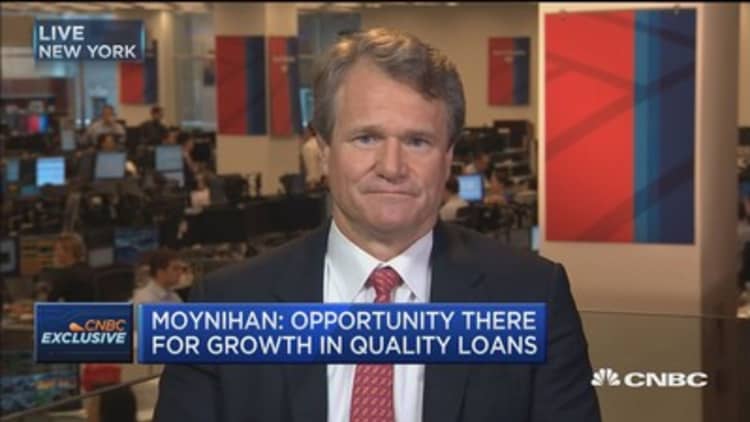Creeping concerns about the consumer's health might be put to rest if next week's August retail sales report is as good as Bank of America CEO Brian Moynihan suggests it might be.
Moynihan, in an interview with CNBC on Thursday, said he was bullish on the consumer and strong spending is showing up in his company's businesses.
"As you look at the month of August, which we just got the final details on, it'll be the strongest consumer spending growth in debit and credit cards year-over-year this year," he said, adding the consumer is "very constructive."

"Year-to-date consumers on our debit and credit cards are spending 4.7 percent more than they did last year, and the pace is accelerating. So, the consumer is in very good shape credit-quality-wise, spending-wise," he said.
Moynihan's comments on August spending patterns are particularly interesting since auto sales slowed in the month and the ISM manufacturing survey and ISM nonmanufacturing survey were both shockingly weaker than expected for the month.
Retail sales, expected next Thursday, are the next really important data for the markets — and the Federal Reserve. Headline retail sales are projected to be flat but up 0.3 percent when auto sales are not counted. Excluding autos, sales fell 0.3 percent in July and were flat on the headline.
"Implicit in what he said is the retail sales number could be really good," said Richard Bove, bank analyst at Rafferty Capital. Bove said JPMorgan Chase CEO Jamie Dimon made a similar comment when his bank's earnings were released last month.
"All of them are seeing the consumer using their credit card to a greater degree and spending aggressively. Even in the GDP figures for the second quarter, even though GDP was up a minimal amount, consumer spending was up 4.2 percent," Bove said.
Diane Swonk, CEO of DS Economics, said the consumer is still doing fairly well and seems to have had a good back-to-school shopping season. She said the sales report could be skewed with heavier spending on building materials because of the flooding in Louisiana and a slowdown in car sales.
"You can have mixed signals. We know the auto sales are down, and we hope the consumers reallocated their money somewhere else," she said. "There has to be a slowdown from the second quarter, at a pace of 4.2 percent."
But both Bove and Swonk point to problems with the way retail sales data are measured by the government, and both say they have been in communication with the Commerce Department which is trying to fix it. Online sales and changes in the way consumers spend are making it very difficult to measure the consumer.
"They're not getting all the online sales," said Swonk. July's retail sales report, for instance, was flat but online spending was higher, raising speculation that Amazon.com's one-day shopping holiday, Prime Day, may have snatched more sales away than normal from bricks-and-mortar retailers.
Bove said the Commerce Department is trying to change its methodology. "That's the issue that we have in looking at the economy. It's pretty simple to see the industrial economy is very troubled. New orders are down, ISM is bad. Capacity utilization is weak. Capital spending is lower than one would hope. All of the data is being picked up reasonably well. On the consumer side, we don't know whether the methodology in place are correctly picking up what the consumer is doing," he said.
Swonk said consumers, about 70 percent of the U.S. economy, are increasing credit card use after the financial crisis dramatically curbed available credit and forced a consumer pullback. She said the consumer is now back to 1995 levels of credit card usage as it relates to GDP.
"The important issue is in the consumer credit numbers — the only growth had been in auto loans and student loans. We're finally moving the needle on the credit cards," she said.
Swonk said auto sales probably peaked, after consumers loaded up on vehicles and car debt. , with Ford seeing a decline of 8.4 percent in U.S. sales, and GM down 5.2 percent. But the annualized pace of sales was still more than 17 million.


